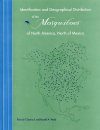Flora / Fauna Identification Key
By: Richard F Darsie, Jr.(Author), Ronald A Ward(Author), Chien C Chang(Illustrator), Taina Litwak(Illustrator)
384 pages, 1045 b/w illustrations, 168 b/w distribution maps
![Identification and Geographical Distribution of the Mosquitoes of North America, North of Mexico Identification and Geographical Distribution of the Mosquitoes of North America, North of Mexico]()
Click to have a closer look
About this book
Customer reviews
Biography
Related titles
About this book
More than ten years after its initial publication, Identification and Geographical Distribution of the Mosquitoes of North America, North of Mexico is now available in paperback. This book updates the successful guide to North American mosquitoes published by the American Mosquito Control Association in 1981. It includes 12 new species that have since been added to the North American mosquito fauna, revised distribution maps of all species, and revised and completely illustrated identification keys for the adult females and fourth instar larvae of all 174 species and subspecies known to occur in North America, north of Mexico.
In chapters on adult and larval morphology, the coauthors – both world-renowned in their field of taxonomy – discuss the anatomical structures mentioned in the keys and pictured on full-page plates. They provide separate generic keys for adult females and larvae and keys to the species of each genus. In addition, they show the geographical distribution of each taxon in a series of maps and include a synopsis of the occurrence of species in the states and provinces of the United States and Canada.
This book's usefulness to mosquito control programs cannot be overestimated. For example, it deals with 9 exotic species that have been introduced and today successfully thrive in North America. Several are increasing their range and this book will help identify these species when they first invade an area.
Because of the occurrence of mosquito-borne diseases and the widespread distribution of mosquitoes as pests to humans, professionals must know how to identify them. With its wealth of up-to-date information, Identification and Geographical Distribution of the Mosquitoes of North America, North of Mexico is the only one of its kind available for specialists working on mosquito-borne diseases and in mosquito control units and for both introductory and advanced students who study entomology.
Customer Reviews
Biography
Richard F. Darsie, Jr. is a research entomologist at the Florida Medical Entomology Laboratory at the University of Florida, USA. Ronald A. Ward was a medical entomologist at the Walter Reed Army Institute of Research in Washington, D.C., before his retirement. Both authors have published extensively in such journals as Mosquito Systematics and the Journal of the American Mosquito Control Association.
Flora / Fauna Identification Key
By: Richard F Darsie, Jr.(Author), Ronald A Ward(Author), Chien C Chang(Illustrator), Taina Litwak(Illustrator)
384 pages, 1045 b/w illustrations, 168 b/w distribution maps
"A one of a kind publication that few if any of the next generation of culicidologists could replicate. Thus, this book will be around and in frequent use for a long time to come."
– Center for Vectorborne Diseases
"What the late Roger Tory Peterson was to birds, the imperial Richard F. Darsie, Jr. Ph.D., is to mosquitoes. If it flies, if it whines, if it bites – and even if it never bites – he can describe it at length. And he will [...] Though humanity frets about terrorists, AIDS and ebola, as teeth are gnashed regarding the unspeakable appetites of sharks and alligators, the most dangerous threat to Homo sapiens most likely remains the humble mosquito."
– South Florida Sun-Sentinel
"This book is now the essential source for the identification of North American mosquitoes. It is a very important milestone in the field of Culicidology."
– Proc. Entomol. Soc. Wash.
"This is 'the' identification manual for North American mosquitoes and should be on the shelf of scientists working with these important insects and in most libraries with strong science holdings."
– Choice
"For the dedicated mosquito worshipper! This book is undoubtedly a must and with its beautifully illustrated key sets a high standard to follow. It will also, no doubt, prove an attractive volume for more general medical entomologists and enthusiastic students of these irksome, dangerous, and fascinating animals."
– Parasitology
"This book is the essential resource for anyone concerned with mosquito control or biology. It is highly recommended for academic and large public libraries and, of course, all libraries concerned with mosquito control and public health."
– American Reference Books Annual (ARBA)
"Anyone studying mosquitoes will want this book!"
– Science Blogs
"A valuable resource [...] The only comprehensive, relatively up to date book on the identification and geographical distribution of mosquitoes in North America, north of Mexico."
– Journal of Medical Entomology



































